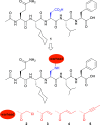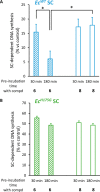Peptide-Based Covalent Inhibitors Bearing Mild Electrophiles to Target a Conserved His Residue of the Bacterial Sliding Clamp
- PMID: 38425897
- PMCID: PMC10900491
- DOI: 10.1021/jacsau.3c00572
Peptide-Based Covalent Inhibitors Bearing Mild Electrophiles to Target a Conserved His Residue of the Bacterial Sliding Clamp
Abstract
Peptide-based covalent inhibitors targeted to nucleophilic protein residues have recently emerged as new modalities to target protein-protein interactions (PPIs) as they may provide some benefits over more classic competitive inhibitors. Covalent inhibitors are generally targeted to cysteine, the most intrinsically reactive amino acid residue, and to lysine, which is more abundant at the surface of proteins but much less frequently to histidine. Herein, we report the structure-guided design of targeted covalent inhibitors (TCIs) able to bind covalently and selectively to the bacterial sliding clamp (SC), by reacting with a well-conserved histidine residue located on the edge of the peptide-binding pocket. SC is an essential component of the bacterial DNA replication machinery, identified as a promising target for the development of new antibacterial compounds. Thermodynamic and kinetic analyses of ligands bearing different mild electrophilic warheads confirmed the higher efficiency of the chloroacetamide compared to Michael acceptors. Two high-resolution X-ray structures of covalent inhibitor-SC adducts were obtained, revealing the canonical orientation of the ligand and details of covalent bond formation with histidine. Proteomic studies were consistent with a selective SC engagement by the chloroacetamide-based TCI. Finally, the TCI of SC was substantially more active than the parent noncovalent inhibitor in an in vitro SC-dependent DNA synthesis assay, validating the potential of the approach to design covalent inhibitors of protein-protein interactions targeted to histidine.
© 2024 The Authors. Published by American Chemical Society.
Conflict of interest statement
The authors declare no competing financial interest.
Figures






Similar articles
-
Modeling the Binding and Conformational Energetics of a Targeted Covalent Inhibitor to Bruton's Tyrosine Kinase.J Chem Inf Model. 2021 Oct 25;61(10):5234-5242. doi: 10.1021/acs.jcim.1c00897. Epub 2021 Sep 30. J Chem Inf Model. 2021. PMID: 34590480
-
A targeted covalent inhibitor of p97 with proteome-wide selectivity.Acta Pharm Sin B. 2022 Feb;12(2):982-989. doi: 10.1016/j.apsb.2021.09.003. Epub 2021 Sep 8. Acta Pharm Sin B. 2022. PMID: 35256959 Free PMC article.
-
A road map for prioritizing warheads for cysteine targeting covalent inhibitors.Eur J Med Chem. 2018 Dec 5;160:94-107. doi: 10.1016/j.ejmech.2018.10.010. Epub 2018 Oct 6. Eur J Med Chem. 2018. PMID: 30321804
-
Recent progress in covalent warheads for in vivo targeting of endogenous proteins.Bioorg Med Chem. 2021 Oct 1;47:116386. doi: 10.1016/j.bmc.2021.116386. Epub 2021 Aug 27. Bioorg Med Chem. 2021. PMID: 34509863 Review.
-
Emerging and Re-Emerging Warheads for Targeted Covalent Inhibitors: Applications in Medicinal Chemistry and Chemical Biology.J Med Chem. 2019 Jun 27;62(12):5673-5724. doi: 10.1021/acs.jmedchem.8b01153. Epub 2019 Jan 25. J Med Chem. 2019. PMID: 30565923 Review.
Cited by
-
Exquisite selectivity of griselimycin extends to beta subunit of DNA polymerases from Gram-negative bacterial pathogens.Commun Biol. 2024 Dec 5;7(1):1622. doi: 10.1038/s42003-024-07175-5. Commun Biol. 2024. PMID: 39639052 Free PMC article.
-
The bacterial DNA sliding clamp, β-clamp: structure, interactions, dynamics and drug discovery.Cell Mol Life Sci. 2024 May 30;81(1):245. doi: 10.1007/s00018-024-05252-w. Cell Mol Life Sci. 2024. PMID: 38814467 Free PMC article. Review.
-
Recent Advances in Augmenting the Therapeutic Efficacy of Peptide-Drug Conjugates.J Med Chem. 2025 May 8;68(9):9037-9056. doi: 10.1021/acs.jmedchem.5c00007. Epub 2025 Apr 23. J Med Chem. 2025. PMID: 40267310 Free PMC article. Review.
-
A fragment-based electrophile-first approach to target histidine with aryl-fluorosulfates: application to hMcl-1.Res Sq [Preprint]. 2025 Mar 26:rs.3.rs-6214862. doi: 10.21203/rs.3.rs-6214862/v1. Res Sq. 2025. PMID: 40196002 Free PMC article. Preprint.
-
Covalent Inhibition of a Host-Pathogen Protein-Protein Interaction Reduces the Infectivity of Streptococcus pneumoniae.JACS Au. 2024 Jun 20;4(7):2484-2491. doi: 10.1021/jacsau.4c00195. eCollection 2024 Jul 22. JACS Au. 2024. PMID: 39055144 Free PMC article.
References
LinkOut - more resources
Full Text Sources
